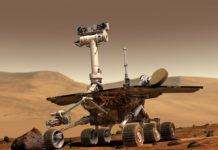This past week, NASA began testing a robot in Antarctica. It is a prototype of a rover designed to function underwater. If the tests are successful, it could be used to seek alien life on Enceladus, one of Saturn’s moons, and Europa, one of Jupiter’s moons.
The rover is called BRUIE (Buoyant Rover for Under-Ice Exploration), and it scans for signs of life while traveling along the bottom ice sheets. NASA hopes to use the rover to look for life on the moons Europa and Enceladus, which are currently believed to be the most likely planets in the solar system to harbor alien life.
BRUIE has two wheels that will enable it to crawl along the ice, and it is buoyant enough to not sink to the bottom of the ocean. Its wheels and buoyancy will enable it to traverse the submerged bottom of ice sheets. BRUIE is also able to resist ocean currents that would otherwise sweep it away.
A mechanical engineer, Dan Berisford, commented in a 2015 video, “Instead of a rover that drives on the ground, we’ll have a rover that drives on the ceiling.”
BRUIE is also able to turn itself off and on. This reduces the amount of energy BRUIE uses so it can explore underwater for months at a time. BRUIE will have instrumentation that will enable it to take such measurements as water salinity, temperature, pressure, and dissolved oxygen. It will also have two rotating high-definition cameras that can take pictures of the sea ice above and the ocean floor below.
NASA has already tested BRUIE in the Arctic and Alaska. The organization plans to send a spacecraft to explore Europa in 2025. It is an icy world that scientists believe conceals an ocean larger than those on Earth. In June, researchers found sodium chloride or table salt in Europa’s ice, which suggests its ocean might resemble the ones on Earth – and thus be able to support life.
Enceladus is a tiny moon orbiting Saturn that is also covered in ice that might conceal an ocean. In 2005, the Cassini spacecraft explored Saturn and some of its moons. It found that Enceladus has water that contains organic compounds.
Europa and Enceladus, however, are much farther away from the sun than is Earth. Consequently, they are also much colder. They do have tides, and scientists speculate that those tides could have caused them to develop hydrothermal vents that would heat the moons from the inside and could support life as do the hydrothermal vents on Earth.






